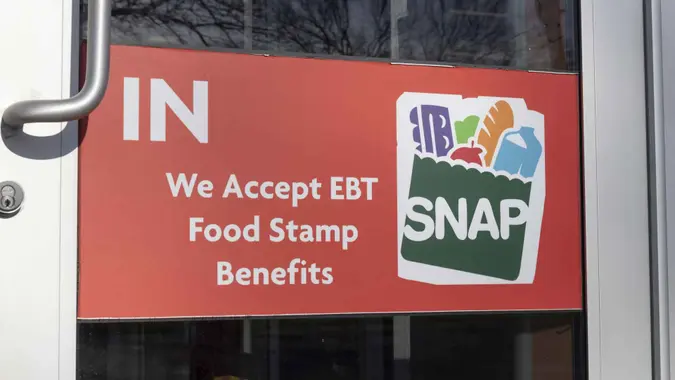4 Ways Mass Deportations Might Affect Your Wallet

Commitment to Our Readers
GOBankingRates' editorial team is committed to bringing you unbiased reviews and information. We use data-driven methodologies to evaluate financial products and services - our reviews and ratings are not influenced by advertisers. You can read more about our editorial guidelines and our products and services review methodology.

20 Years
Helping You Live Richer

Reviewed
by Experts

Trusted by
Millions of Readers
Now that President Donald Trump is back in the Oval Office as commander-in-chief, mass deportations of immigrants lacking permanent legal status is a major focus for his administration. Trump promised to make this mass deportation event, or string of events, the largest the U.S. has ever seen. It’s a promise he’s expected to make good on and one he’s already made moves to fulfill.
It’s well understood that deporting these immigrants will mean financial havoc for those affected, but what about those who are not directly impacted? Can it affect their wallets? You may be surprised to learn that it can, regardless of where on the political spectrum you fall.
Higher Prices on Many Goods and Services
We often hear about how immigrants lacking permanent legal status are taking jobs away from citizens. Let’s look at the nuance here. There is a significant disparity between the income of citizens and immigrants without permanent legal status. For example, in California in 2021, the median hourly wage for citizens was $24 and $16 for immigrants lacking legal status. So, though you can argue that these immigrants are taking jobs that could be filled by citizens, you must also recognize that immigrants are working said jobs for far less than what citizens would deem acceptable. The question that emerges is, “Will citizens work for these rock-bottom wages?” Additionally, “Will they work jobs that are infamously physically taxing and tedious for those rock-bottom wages?” Usually not.
“Undocumented workers work disproportionately in jobs that native-born Americans will not do,” said Julia Rueschemeyer, an attorney. “Americans who grow up in this country will not do tedious, back-breaking work such as weeding and harvesting fruit and vegetables in vast California or Florida fields. Americans who grow up here will not work in fetid, dangerous slaughterhouses (think of dangerous factory work surrounded with the stench of freshly killed animals and blood). Americans who grow up here will not put roofs on houses in Arizona or anywhere in the South where on-roof temperatures are over 100 degrees all day long most of the year.”
So how does any of this affect your wallet? The bottom line: The businesses hiring for these jobs that generally citizens aren’t as willing to do as immigrants without permanent legal status will have to pay a lot more to lure and retain talent. To be able to afford that, they’ll hike up prices on their goods.
“If business owners have to pay $40/hour for unskilled agricultural work to get native-born Americans to pick lettuce, prices for everyone will skyrocket,” Rueschemeyer said. “Large scale deportations will immediately raise the prices we see at the grocery store and raise home construction costs (even as America has a housing shortage). This will lead to inflationary pressure. These are simple economic laws of supply and demand.”
A Slow in Job Growth
We may also see a sluggish job market on the heels of mass deportations. This is where the consumer aspect comes into play. When you remove a swath of the population (in this case, immigrants without permanent legal status), you also remove the money they spend as consumers.
“When a large portion of the workforce is suddenly removed, there’s less consumer demand and spending,” said Seth Persily, founder and legal expert, Elite Litigators. “This could lead businesses to cut back on hiring, reducing the number of new jobs available. According to reports, if there’s a drop in immigration, job growth could slow by up to 100,000 jobs a month. For everyday people, this means fewer opportunities in the job market and, potentially, slower wage growth in the long run.”
Decrease in Rental Demand in Some Areas
Here’s one that affects the wallets of real estate investors. In their first two years in the U.S., the large majority of immigrant in the U.S. are almost all renting homes, as opposed to owning them. When they go, we could see more housing open up. Though this would behoove prospective renters, it could also lead to a decrease in rental demand that would hurt landlords.
“When large numbers of people are suddenly removed from a community, there will naturally be fewer renters looking for housing,” said Robert Fausette, owner, Revival Homebuyer. “This can result in landlords struggling to find tenants for their properties, leading to longer vacancies and potentially lower rent prices.”
If you own rental properties in an area with high immigrant populations, such as Los Angeles or El Paso, Texas, mass deportations can also negatively impact your cash flow.
“With tenants being forced to leave the country, you may suddenly find yourself with unexpected vacancies and a loss of rental income,” Fausette said.
A Property Value Decrease in Some Areas
As a result of mass deportations, we may also see long-term effects on property values in areas where deportation rates are high. This happens because the core of the local community is uprooted. When people are removed from their homes, we often see a ripple effect on the local housing market. There are evictions and foreclosures — both of which, if happening on a grand scale, can drive down the value of a local market.
“If a large portion of a community’s population is suddenly uprooted, it can create a ripple effect on the local housing market.” Keith Sant, founder and CEO, Kind House Buyers. “Demand for homes may decrease, causing prices to drop and homeowners to lose equity in their properties.”
Editor’s note on political coverage: GOBankingRates is nonpartisan and strives to cover all aspects of the economy objectively and present balanced reports on politically focused finance stories. You can find more coverage of this topic on GOBankingRates.com.
 Written by
Written by  Edited by
Edited by 

























